Properties of Stones | Requirements of Good Building Stones
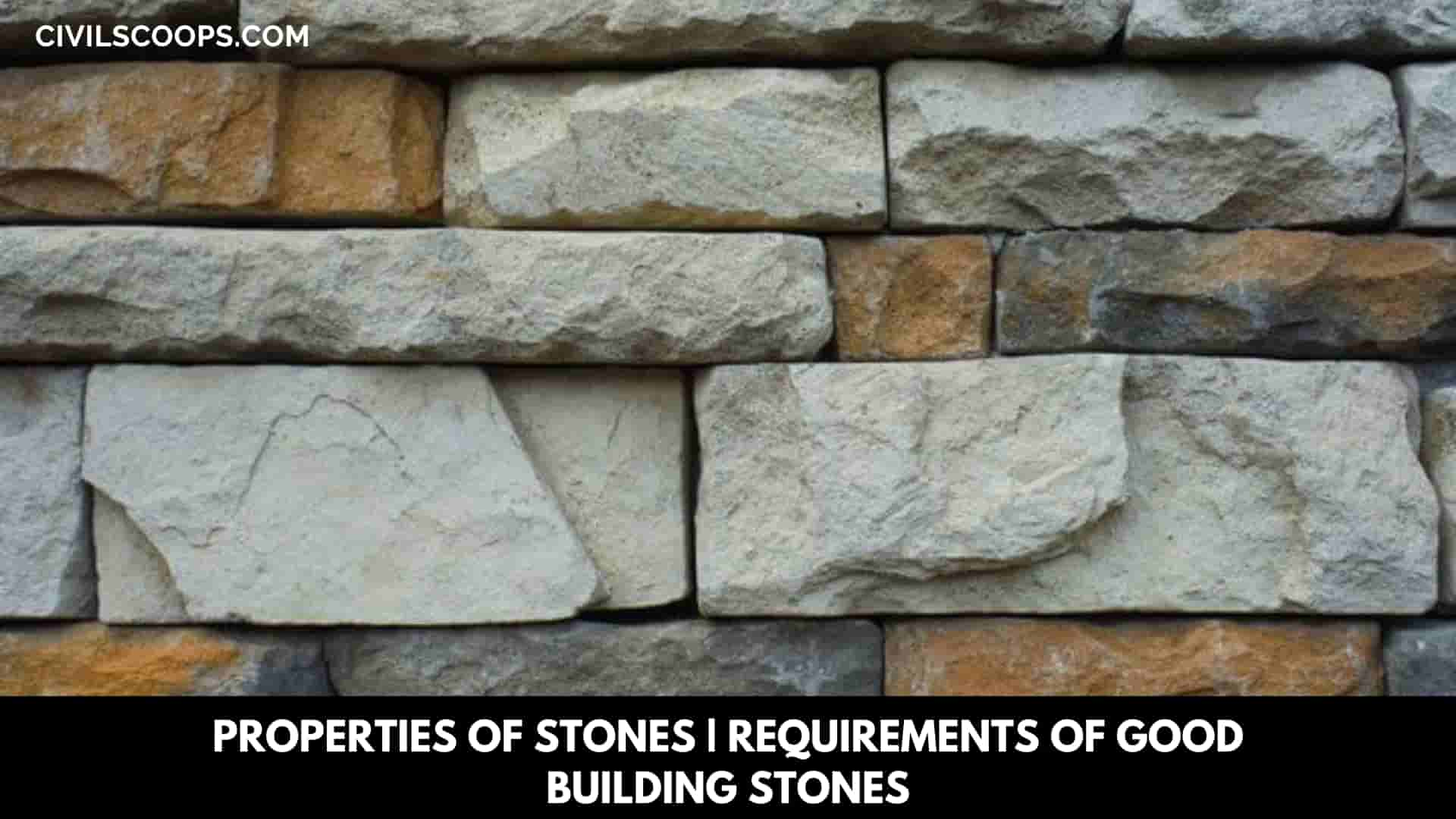
Table of Contents
Properties of Stones
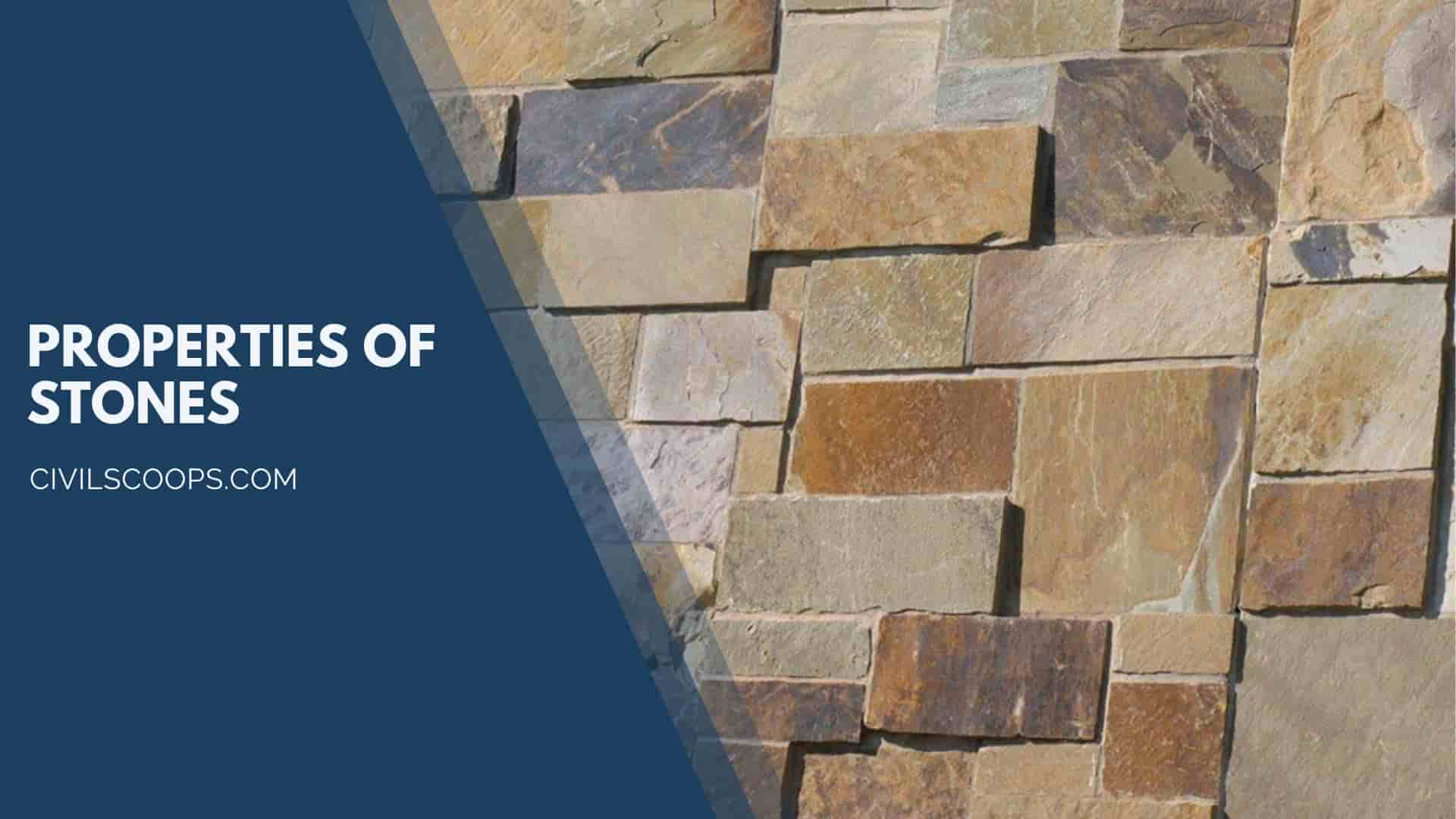
The following properties of the stones should be looked into before selecting them for engineering works:
- Structure.
- Texture.
- Density.
- Appearance.
- Strength.
- Hardness.
- Percentage Wear.
- Porosity and Absorption.
- Weathering.
- Toughness.
- Resistance to Fire.
- Ease in Dressing.
- Seasoning.
1. Properties of Stones: Structure

The structure of the stone may be stratified (layered) or unstratified. Structured stones should be easily dressed and suitable for the superstructure.
Unstratified stones are hard and difficult to dress. They are preferred for foundation works.
2. Properties of Stones: Texture
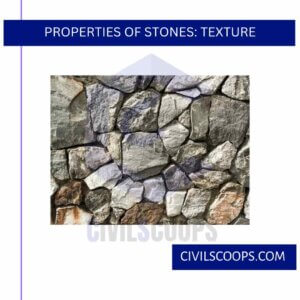
Fine-grained stones with homogeneous distribution look attractive and hence they are used for carving. Such stones are usually strong and durable.
3. Properties of Stones: Density

Denser stones are stronger. Light-weight stones are weak. Hence stones with a specific gravity of less than 2.4 are considered unsuitable for buildings.
4. Properties of Stones: Appearance
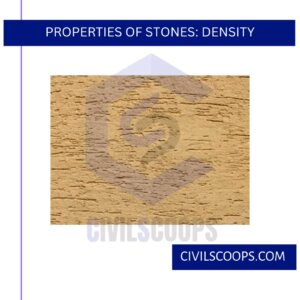
A stone with uniform and attractive color is durable if grains are compact. Marble and granite get a very good appearance, when polished. Hence they are used for face works in buildings.
5. Properties of Stones: Strength
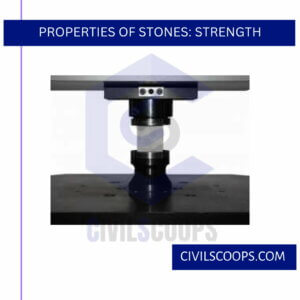
Strength is an important property to be looked into before selecting stone as a building block. Indian standard code recommends, a minimum crushing strength of 3.5 N/mm2 for any building block.
Table 1 shows the crushing strength of various stones. Due to the non-uniformity of the material, usually, a factor of safety of 10 is used to find the permissible stress in a stone.
Hence even laterite can be used safely for a single-story building because in such structures expected load can hardly give stress of 0.15 N/mm2.
However, in stone masonry buildings care should be taken to check the stresses when the beams (Concentrated Loads) are placed on a laterite wall.
[su_table responsive=”yes” alternate=”no”]
| Name of Stone | Crushing Strength in N/mm2 |
| Trap | 300 to 350 |
| Basalt | 153 to 189 |
| Granite | 104 to 140 |
| Slate | 70 to 210 |
| Marble | 72 |
| Sand Stone | 65 |
| Lime Stone | 55 |
| Laterite | 1.8 to 3.2 |
[/su_table]
Table 1. Crushing Strength of Common Building Stones
6. Properties of Stones: Hardness
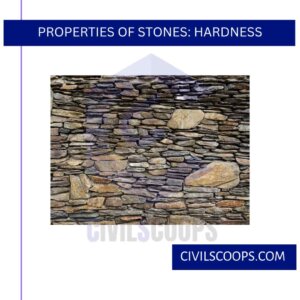
It is an important property to be considered when a stone is used for flooring and pavement. The coefficient of hardness is to be found by conducting a test on a standard specimen in Dory’s testing machine.
For road works coefficient of hardness should be at least 17. For building works stones with a coefficient of hardness less than 14 should not be used.
7. Properties of Stones Percentage: Wear
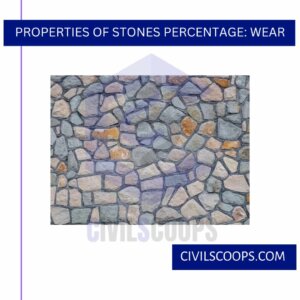
It is measured by the attrition test. It is an important property to be considered in selecting aggregate for road works and railway ballast. A good stone should not show wear of more than 2%.
8. Properties of Stones: Porosity and Absorption
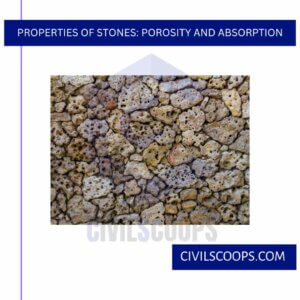
All stones have pores and hence absorb water. The reaction of water with a material stone cause disintegration. The absorption test is specified as the percentage of water absorbed by the stone when it is immersed underwater for 24 hours. For a good stone, it should be as small as possible and in no case more than 5.
9. Properties of Stones: Weathering
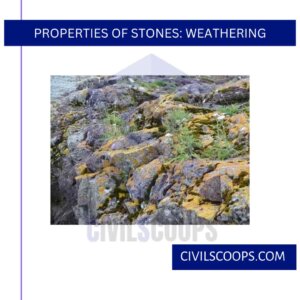
Rain and wind cause the loss of the good appearance of stones. Hence stones with good weather resistance should be used for face works.
10. Properties of Stones: Toughness
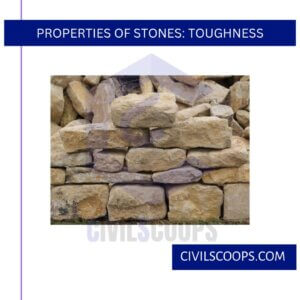
The resistance to impact is called toughness. It is determined by the impact test. Stones with a toughness index of more than 19 are preferred for road works.
A toughness index of 13 to 19 is considered medium tough and stones with a toughness index less than 13 are poor stones.
11. Properties of Stones: Resistance to Fire

Sandstones resist fire better. Argillaceous materials, though poor in strength, are good at resisting fire.
12. Properties of Stones: Ease in Dressing

The cost of dressing contributes to the cost of stone masonry to a great extent. The dressing is easy in stones with lesser strength. Hence an engineer should look into sufficient strength rather than high strength while selecting stones for building works.
13. Properties of Stones: Seasoning
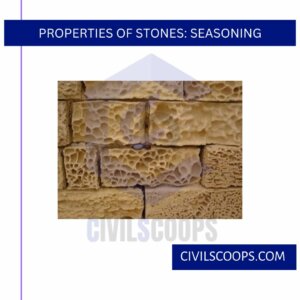
The stones obtained from the quarry contain moisture in the pores. The strength of the stone improves if this moisture is removed before using the stone.
The process of removing moisture from pores is called seasoning. The best way of seasoning is to allow it to act in nature for 6 to 12 months. This is very much required in the case of laterite stones.
Also Read: What Is Cinder Block | Cinder Block Properties | Shapes of Cinder Blocks | Advantages of Cinder
Requirements of Good Building Stones
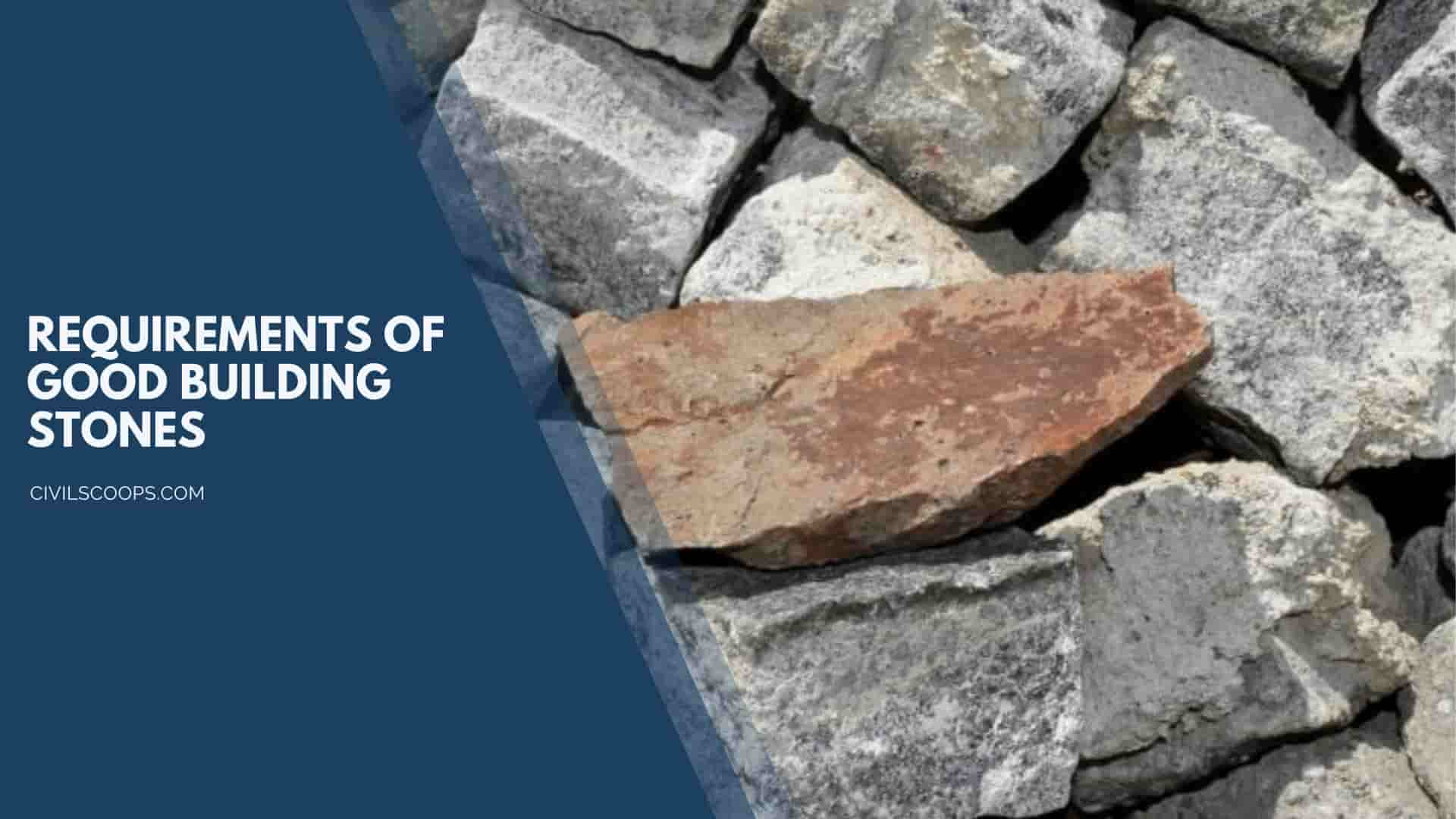
The following are the requirements for good building stones:
- Strength
- Durability
- Hardness
- Toughness
- Specific Gravity
- Porosity and Absorption
- Dressing
- Appearance
- Seasoning
- Cost
- Strength: The stone should be able to resist the load coming on it. Ordinarily, this is not of primary concern since all stones are having good strength. However, in the case of a large structure, it may be necessary to check its strength.
- Durability: Stones selected should be capable of resisting adverse effects of natural forces like wind, rain, and heat.
- Hardness: The stone used in floors and pavements should be able to resist abrasive forces caused by the movement of men and materials over them.
- Toughness: Building stones should be tough enough to sustain stresses developed due to vibrations. The vibrations may be due to the machinery mounted over them or due to the loads moving over them. The stone aggregates used in road construction should be tough.
- Specific Gravity: A heavier variety of stones should be used for the construction of dams, retaining walls, docks, and harbors. The specific gravity of good building stone is between 2.4 and 2.8.
- Porosity and Absorption: Building stone should not be porous. If it is porous rainwater enters the pour and reacts with the stone and crumbles it. In higher altitudes, the freezing of water in pores takes place and it results in the disintegration of the stone.
- Dressing: Giving the required shape to the stone is called dressing. It should be easy to dress so that the cost of dressing is reduced. However, care should be taken so that, this is not at the cost of the required strength and durability.
- Appearance: In the case of the stones to be used for face works, where appearance is a primary requirement, their color and ability to receive polish is an important factors.
- Seasoning: Good stones should be free from the quarry sap. Laterite stones should not be used for 6 to 12 months after quarrying. They are allowed to get rid of quarry sap by the action of nature. This process of removing quarry sap is called seasoning.
- Cost: Cost is an important consideration in selecting a building material. The proximity of the quarry to the building site brings down the cost of transportation and hence the cost of stones comes down.
[su_box title=”FAQ” style=”default” box_color=”#333333″ title_color=”#FFFFFF” radius=”3″ class=”” id=””]
What Is a Stone?
The stone or stone weight is an English and imperial unit of mass equal to 14 pounds. The stone continues in customary use in the United Kingdom for body weight.
What Are Stones Made Of?
Rocks are composed primarily of grains of minerals, which are crystalline solids formed from atoms chemically bonded into an orderly structure. Some rocks also contain mineraloids, which are rigid, mineral-like substances, such as volcanic glass, that lack crystalline structure.
Type One Stone
Type 1 is a granular, well-graded material sized from 63mm to dust, but with most of the material sized at 31.5mm to dust. Available both as a limestone or granite, Type 1 SHW Clause 803 (formerly MOT Type 1) is widely used as a sub-base in the construction of roads, car parks, and pathways.
Type 1 Crushed Stone
Crushed stone #1 is the largest of the crushed stone grades and includes stone that is between 2-4 inches. This material is great for larger jobs or for filling in larger holes.
What Is Building Stone?
Building stone is a rock that is used in the construction of buildings, retaining walls, bridges, and other structures and includes building components such as walls, foundations, sills, chimneys, and steps.
Good Building Stone
Good building stone should be homogeneous in structure. Stones with homogeneous and crystalline textures are hard and compact and superior to non-crystalline and open-texture varieties. Generally, igneous and metamorphic rocks such as granite, trap, and gneiss are hard and compact.
Quality of Good Building Stone
Good building stones must compose a fine crystalline structure that should be free from cavities, cracks, or patches of soft or loose material. Stones with such texture are so strong and durable. Toughness Index: If the value of the toughness index comes below 13 in the impact test, then the stone is not tough.
Structure of Stone
The structure of the stone may be stratified (layered) or unstratified. Structured stones should be easily dressed and suitable for the superstructure. Unstratified stones are hard and difficult to dress. They are preferred for foundation works.
Density of a Stone
Most of the rocks comprising the crust of the earth have a density between 2.6 and 2.7g/cc.
Stone Appearance
Marble will normally show “veins” or high concentrations. The minerals in granite will typically appear as small flecks distributed uniformly in the stone. Each type of stone is unique and will vary in color, texture, and marking. Sandstones vary widely in color due to the different minerals and clays found in the stone.
Physical Properties of Stone
Important properties include the rocks’ color, color intensity, color blend, grain size, structure, and texture. It is also important for the appearance and color of the stone surface to be durable and for the rock to withstand weathering and discoloration.
Mechanical Properties of Stone
The two most important criteria in assessing natural stones as building materials are their technical or material properties such as density, porosity, hardness, compressive and flexural strength, thermal conductivity, etc., and the demand for the stone type (2).
Strength of Stone
The average compressive strength of the stone, when the load is parallel to and perpendicular to the bands, is 104.9 MPa and 86.1 MPa, respectively.
What Stones Are Porous?
Pearl, opal, emerald, amber, coral, onyx, agate, and dolomite are all classed as soft porous, which means they are softer, more vulnerable to water damage, and need special care to maintain their beauty.
Water Absorption Test for Stone
Absorption. The absorption test measures the degree to which water will penetrate a stone, measured at a weight percentage. A stone sample is cut to a specified size, kiln-dried, and then weighed accurately. The dry sample is then immersed in water for a specified period of time and then weighed again.
Toughness of Stone
Stones with such texture are so strong and durable. Toughness Index: If the value of the toughness index comes below 13 in the impact test, then the stone is not tough. If the value comes in between 13 & 19 then the stone is said to be moderately tough and if it exceeds 19 then the stone is said to be highly tough.
What Is Seasoning of Stone?
After quarrying and dressing, the stone still retains natural moisture within. This moisture is called quarry sap. The removal of this moisture by cyclic drying and airing is called the seasoning of stone. This moisture if not removed may render the stone to be soft and weak.
Durability of Stone
Stone, in general, is considered a durable material; however, not all stones are as durable as one might anticipate. Stone durability is dependent on its composition, which can affect strength and appearance, and environmental exposure factors.
Most Durable Stone
Granite — Not only is granite beautiful, but it’s also more durable and resistant to freeze-thaw cycles than most other hardscape materials. In addition, granite has a low absorption rate and is highly resistant to fire and heat.
What Is Specific Gravity of Stone?
Specific gravity in natural stone ranges from 2 to 3, meaning that stone is two to three times denser than water.
Is the Sword in the Stone Real?
The sword King Arthur pulled from the stone in legend was likely just that–legendary. This sword, with a story equally as unbelievable, actually exists in Tuscany’s Montesiepi Chapel. Galgano Guidotti was born in 1148 near Chiusdino.
Where Is the Real Stone of Destiny?
The Stone of Destiny can be seen in the Crown Room of the Royal Palace, along with the Crown Jewels and other priceless treasures. It is on loan from the Commissioners for the Keeping of the Regalia. The stone will only leave Scotland again for a coronation in Westminster Abbey.
What Is a Circle of Standing Stones Called?
One of the most famous sites in the world, Stonehenge is the remains of a ring of standing stones set within earthworks. It is in the middle of the densest complex of Neolithic and Bronze Age monuments in England, including several hundred burial mounds. Stonehenge – Public Domain.
Is Stone Mountain a National Park?
Stone Mountain Park, which surrounds the Confederate Memorial, is owned by the state of Georgia and managed by the Stone Mountain Memorial Association, a Georgia state authority.
How to Build a Stone Wall?
Step 1: Sort Stones. Sort the stones into size groups.
Step 2: Add Gravel and Lay First Course. Shovel about 4 inches of gravel into the trench; level and tamp it.
Step 3: Fill the Wall and Continue.
Step 4: Check the Batter.
Step 5: Lay Top Course.
Is Sandstone Good for Building?
Sandstone is a durable building material, but its appearance will change over time. Historic buildings are expected to show signs of aging, including some soiling. Aged masonry surfaces often develop a natural patina, which is considered very valuable as it adds a sense of history and endurance to older structures.
Characteristics of Stones
However, there are general qualities that are characteristic of all stones. Some common characteristics include appearance, weight, durability, strength, hardness, porosity, and resistance to fire and electricity.
Properties of Stones
- Structure.
- Texture.
- Density.
- Appearance.
Qualities of Good Building Stones
Crystalline, close-grained, homogeneous, and densely packed structure, Little or no porosity, Uniformity of a freshly broken or cut surface, Ease of quarrying and dressing.
[/su_box]
[su_note note_color=”#F2F2F2 ” text_color=”#333333″ radius=”3″ class=”” id=””]
Like this post? Share it with your friends!
Suggested Read –
- What Is a Classified Road | Classification of Roads in India
- What Is Falsework | Types of Falsework | Causes of Falsework Failures
- Alignment of Road | Alignment in Design | Horizontal Alignment of Road | Vertical Alignment of Road
- Mortar Vs Grout| What Is Mortar and Grout| Type of Mortar and Grout| Difference Between Mortar and Grout
- What Is Azimuths Surveying | What Is Bearings Surveying | Difference Between Azimuths and Bearings in Surveying
[/su_note]
Originally posted 2023-03-02 08:27:33.
